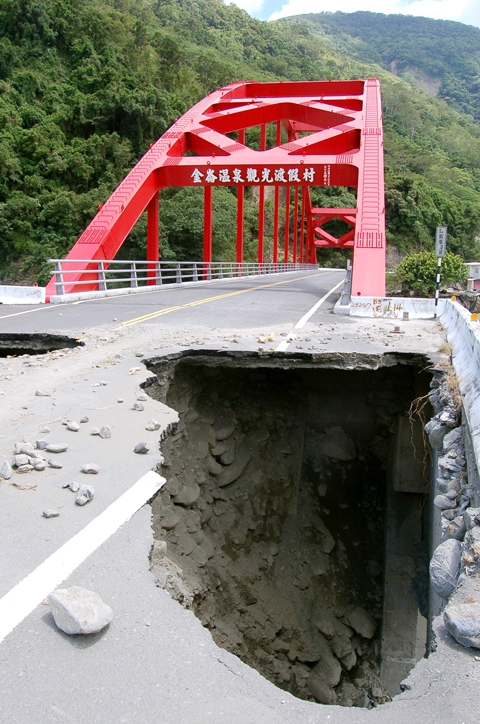The impact of Typhoon Morakot is likely to interrupt the nation’s economic recovery by postponing production until next month, but post-disaster reconstruction work will offer a firm support that the nation needs, economists said.
The typhoon, which struck Taiwan between Aug. 7 and Aug. 10, has triggered the nation’s most severe flooding and mudslides in 50 years. It impaired roads and bridges, disrupted power and water supplies and damaged 27 percent of the nation’s farmland, causing hundreds of millions of dollars in total losses.
“The destruction from the typhoon will continue to be felt throughout the island’s economy in coming quarters,” Tine Olsen, an economist at Moody’s Economy.com based in Sydney, said in a research note on Friday.

PHOTO: WANG HSIU-TING, TAIPEI TIMES
As of 9am yesterday, agricultural losses caused by the typhoon had amounted to NT$12.24 billion (US$372 million), according to statistics compiled by the Council of Agriculture.
Some 15,963 out of 1.59 million households throughout Chiayi, Kaohsiung, Pingtung and Taitung counties were still experiencing power outages, while 57,885 out of 860,000 households in typhoon-hit areas remained without running water, the Ministry of Economic Affairs said yesterday.
Morkot also created havoc on public transportation and infrastructure. It caused damage to 246 sections of roads, with 95 sections waiting for repairs as of yesterday, the Central Disaster Emergency Operation Center said in a statement.
About 20 bridges were either damaged or washed away after Morakot, the Ministry of Transportation and Communications said last week, but the Chinese-language **United Evening News reported on Saturday that 70 bridges were destroyed, citing Yao Nai-jia (姚乃嘉), a professor at the Center for Bridge Engineering Research at National Central University.
As Kaohsiung Port, the nation’s largest container port, is located in areas where Morakot hit public transportation, Olsen said it would cause a delay in both inbound and outbound shipments.
“Though the bottleneck in outbound shipments will not make long-run dents in the economy, it will postpone production from August to September,” she said. “The disruption of supply of inputs could nevertheless take a bite [out] of output, since production will be lower when imports arrive late.”
Olsen warned that damage to production facilities in disaster areas — if not repaired soon — could also weigh on production in the third quarter, and possibly into the fourth quarter.
An example is Advanced Semiconductor Engineering Inc (日月光半導體), the world’s largest chip packaging and testing company, which last week had to truck in water to maintain normal operations at its factories in Kaohsiung’s Nantze Export Processing Zone (楠梓加工出口區) after Morakot muddied up local water supplies.
Cheng Cheng-mount (鄭貞茂), head economist at Citigroup Taiwan Inc, said the typhoon damage this time was mainly in agriculture, tourism and some infrastructure projects, but the damage to Taiwan’s nominal GDP growth rate would be less than 0.1 percentage point.
“Major tech factories were unscathed and with still low capacity utilization ratio, we don’t think the typhoon damage will justify a downward vision to our GDP forecast for this year,” Cheng said in a client note on Friday.
Johnny Chen (陳擎宏), deputy manager of the economics and industry research department at First Commercial Bank (第一銀行), also said the typhoon damage would have little impact on the economy.
“The disaster will probably tip the gauge slightly downward for this quarter but will push it up by a bigger scale later as the government pumps in more funds to fix broken bridges, roads and other infrastructure,” Chen said by telephone on Friday, after the Executive Yuan announced it would draft a special budget of around NT$110 billion to fund the reconstruction work.
If a special statute for this level of extra funds is approved by the Legislature on Thursday, Chen said the reconstruction work would be a benefit to the economy as it helps raise demand for construction materials and create more job opportunities, while Olsen said the reconstruction projects would push investments higher in the fourth quarter and into next year.
The Directorate-General of Budget, Accounting and Statistics (DGBAS) is due to release its second-quarter GDP figure and forecasts for the following two quarters and the whole year on Thursday.
Economists had previously predicted the DGBAS would adjust its GDP data upward next week in the wake of faster-than-expected economic improvements in the April-June period.
Now, Chen said the DGBAS might have to consider the negative impact of the typhoon, although he did not provide a specific forecast. On May 20, the DGBAS predicted the economy would decline 2.98 percent in the July-September quarter from a year ago, before seeing a 5.2-percent recovery in the fourth quarter.
Nevertheless, Chen said the GDP figure is not a perfect indicator of the quality of people’s life.
“It does not factor in property losses or people killed by the disaster,” he said.

Quanta Computer Inc (廣達) chairman Barry Lam (林百里) is expected to share his views about the artificial intelligence (AI) industry’s prospects during his speech at the company’s 37th anniversary ceremony, as AI servers have become a new growth engine for the equipment manufacturing service provider. Lam’s speech is much anticipated, as Quanta has risen as one of the world’s major AI server suppliers. The company reported a 30 percent year-on-year growth in consolidated revenue to NT$1.41 trillion (US$43.35 billion) last year, thanks to fast-growing demand for servers, especially those with AI capabilities. The company told investors in November last year that

Intel Corp has named Tasha Chuang (莊蓓瑜) to lead Intel Taiwan in a bid to reinforce relations between the company and its Taiwanese partners. The appointment of Chuang as general manager for Intel Taiwan takes effect on Thursday, the firm said in a statement yesterday. Chuang is to lead her team in Taiwan to pursue product development and sales growth in an effort to reinforce the company’s ties with its partners and clients, Intel said. Chuang was previously in charge of managing Intel’s ties with leading Taiwanese PC brand Asustek Computer Inc (華碩), which included helping Asustek strengthen its global businesses, the company

Taiwanese suppliers to Taiwan Semiconductor Manufacturing Co. (TSMC, 台積電) are expected to follow the contract chipmaker’s step to invest in the US, but their relocation may be seven to eight years away, Minister of Economic Affairs J.W. Kuo (郭智輝) said yesterday. When asked by opposition Chinese Nationalist Party (KMT) Legislator Niu Hsu-ting (牛煦庭) in the legislature about growing concerns that TSMC’s huge investments in the US will prompt its suppliers to follow suit, Kuo said based on the chipmaker’s current limited production volume, it is unlikely to lead its supply chain to go there for now. “Unless TSMC completes its planned six

TikTok abounds with viral videos accusing prestigious brands of secretly manufacturing luxury goods in China so they can be sold at cut prices. However, while these “revelations” are spurious, behind them lurks a well-oiled machine for selling counterfeit goods that is making the most of the confusion surrounding trade tariffs. Chinese content creators who portray themselves as workers or subcontractors in the luxury goods business claim that Beijing has lifted confidentiality clauses on local subcontractors as a way to respond to the huge hike in customs duties imposed on China by US President Donald Trump. They say this Chinese decision, of which Agence